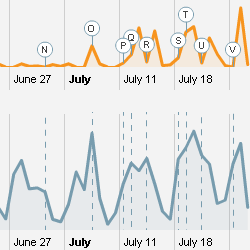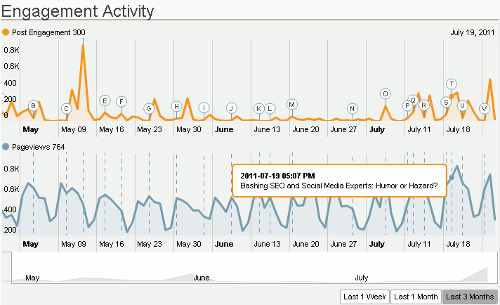
People really are friendly. At least that’s my view. They may not always have a great day, and they may be disappointing at times, but I still love people. It feels great to express it, too. Most people really do have a kind side. As long as that’s the side you’re appealing to, the result is like magic.
Even when you doubt them, sometimes you’ve just got to take the plunge, and believe in people.
I want to share something I find fascinating about the nature of people. I also hope that since my blog is about marketing and business, you will relate to how this applies to your business. I’m even going to point out what I believe is the most popular thing on the whole Internet – even more popular than sex and bacon – and I think you’ll agree with me.
Stop and Smell the People … Err – Roses
None of us would be very good without the others around us. I imagine that same need for people is a strong reason social media is so popular. We get to connect, share, brainstorm, encourage, and gain a connection with more people – awesome people. So, I’ll repeat it – I love people – even the disappointing ones who are having a bad day.
People may not always realize exactly why they do it at the time, but being good to others makes them feel good. I believe it is a baseline reflex that is built into each of us, and those who neglect that reflex do so at their own peril.
Even when there is not a large perceived personal benefit, and sometimes especially because there is not a large perceived personal benefit, people move together for a common action. I’ve witnessed it my whole life, and it still amazes me every day.
Making others feel good spreads far and wide. In fact, I’d like to challenge you to find anything more “viral” on the Internet than a smile. If you doubt it, just consider how many times you’ve seen this: 🙂
Job-Seeking Taught Me a Lesson
What brought this to mind for me today is the friendliness of people when I recently asked them to assist me in a very meaningful career endeavor. I reached out to a small handful of people for friendly advice and assistance to reach Steve Phelps, Senior Vice President and CMO at NASCAR. I humbly asked a circle of friends for introductions to others who could provide me with even more friendly advice and introductions. I didn’t ask for a large sacrifice, or a huge piece of their time, but I was amazed to find them giving their time freely, and without seeking a return.
You see, I’m a marketing guy with a passion for racing. It makes sense that Steve Phelps received the very first résumé and cover letter I sent in what seems like a squillion years. People knew it means a lot to me, so they gave freely.
It was as if I had simply asked them for a glass of water, and they were delighted to help.
For those people, the greatest return is perhaps just my sincere thanks, and a smile they can spread to others. They made me feel good, and knowing how it feels when I do something similar, I know it made them feel good. I’m not selling anything here, but I even wrote a book that focused on the great benefits of being good to others … and imagine what happened … it made me feel very good!
The Pursuit of Meaningful Work
I’ll back up just a bit. In December, I decided that I would stop taking new marketing clients in 2012. I announced it, but I said I would have another announcement to come. On January 2nd, I solidified it, and officially bid sayonara to mediocrity. Today’s announcement is where I’m going next.
I’ve heard it surprised some people when I stopped taking clients. Those who know me probably did not imagine where I decided I wanted to go with this career. That’s because it sounds like a step down … and it is, in some ways. I’ve run a successful corporation for over a decade, and before that, I was retired for a while and resting on the good fortune of a previous endeavor. Some people would ask what in the heck a guy like that wants with a job working for somebody else. I’ll tell you just that.
I’ve been a CEO and business owner my entire adult life. I’ve participated in board meetings and advised corporations since I was a teenager. I’ve seen a lot, done a lot, and enjoyed a lot. I’ve also been the guy who is handed many of the hardest decisions. I’m good at decisions, for the most part, but one I battled with for a while is to change my career and stop being the guy who is supposed to be good at everything. I want to focus on the things I am the best at, and that’s marketing. I feel it is a healthy and productive change for me, and I’m prepared to go “both feet in”.
Maybe this will encourage you, too. I hope it will.
Going “Both Feet In”
I’ve witnessed many people who want a lot in life, but are afraid to ask for it. I think that kind of fear affects each of us on some level, at some time. Asking for something simple from a few of my inner circle of friends has reminded me that it is important to ask for what you want, and recognize that many people will go out of their way to be helpful. I teach this principle, and I do it for clients every day, but it is easy to neglect even my own good advice.
I don’t often ask a lot from people around me, so this was a really great reminder to practice what I preach. I hope you will take this good advice from me. Ask for it! Have a call to action! If you don’t, you’re missing out on most of the best results.
You will not always get it just right, but if you never take a risk, you may never know what you’ve missed. I don’t want to live with those doubts, so I believe there are times to go “both feet in”.
Here’s a little Racing 101 course that you can apply to your marketing.
The term “both feet in” is a term used in racing when you’ve tried to recover from a slide and the car is not in agreement. You let go of the steering wheel (before its rapid spinning breaks your hand) and put both feet to the floor – one on the brake, and one on the clutch. It’s a thrill ride, but not in the way we drivers prefer it. It slows us down, and hopefully keeps us off the wall. It quickly resets our objectives.

This happens when you know that steering and throttle alone will not correct the car’s angle, and it’s time to save what you can of the car and your safety. All the while, time moves slowly, and you just want to get back in the race.
For experienced drivers, this only happens once in a long while, and preferably only in practice. As out of control as it may sound, it’s often well-calculated and happens when we’ve decided to lay on the gas a bit harder and earlier as we come out of a turn. Sometimes you have to push the limits to know the limits, and sometimes you have to take a risk. That’s how you get big speed on the straights, and that’s how you win races.
I love racing. I even love analogies about racing, so I’ll give you one. I believe today is a great day to push the throttle hard and risk a “both-feet-in” ride. I’m pushing the throttle on a new career directive, and I hope you can offer me a friendly hand to exit the turn with more speed than ever.
I’ll describe the race course, and I hope you’ll find it as easy as a glass of water. I also hope you will find inspiration in seeking a glass of water for yourself.
How About That Glass of Water?
My “both feet in” moment is when I ask you to help me reach the right person with my message. Here’s the simple “glass of water” I’m seeking:
- If you have a friend, colleague, or know a company that you believe can benefit from my skills of 25 years in marketing, please introduce me.
- If you have a connection with anybody at NASCAR, BMW, Porsche, Mazda, Ford, Audi, or any other automotive, racing-oriented, engineering, or high-technology companies – or recruiters for such things – please introduce me. I’m not married to automotive, either. Like I said, I love people, and the people and culture of the company will matter more than the industry … or even the pay scale. Most importantly, they must appreciate the difference between just doing something, and doing it well.
- Take a look at my résumé to find out what I know about my area of expertise, and get to know a little more about me. I have extensive experience in marketing and business consulting. I want to share that experience for the benefit of my next employer.
- Let’s brainstorm. I’m an analytic guy with a lot of imagination. I may have some good ideas for you, too. I’m not selfish with the thoughts that race through my mind, and I’m usually happy to share some inspiring ideas.
- Please spread this message and help me with my goal of finding the right match in an employer. That would mean a lot to me, and you have nothing to lose. Twitter, LinkedIn, and Facebook are some great places to start. Anything is appreciated.
It will not cost you any more than a glass of water to help me, and it will most certainly make somebody smile … and probably more than only me.
Does that sound self-serving? I guess maybe it does, but if you know me at all, you know I would do the same for you and I would smile the rest of the day just for feeling helpful.

Photo Credit:
Glass of Water by Michael Hamann via Flickr
Podcast: Play in new window | Download








